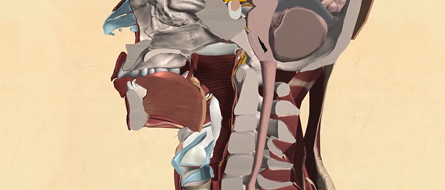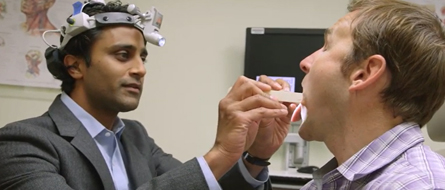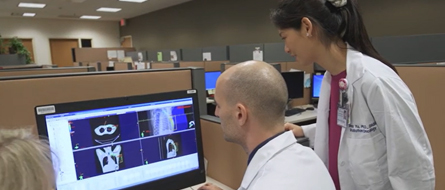What is pharyngeal (throat) cancer?
Pharyngeal cancer is a type of head and neck cancer that develops in the throat (pharynx). This air and food passageway starts behind the nose and ends at top of the trachea (windpipe) and esophagus. The three parts of the pharynx where pharyngeal cancer can start include:
- Nasopharynx, the top part behind the nose
- Oropharynx, the middle section, which is visible when opening your mouth and often called the back of the throat
- Hypopharynx, also called the laryngopharynx, the lowest section behind the voice box (larynx)
Throat cancer can also start in the larynx, which contains the vocal cords and sits in front of the hypopharynx.
How does pharyngeal cancer develop?
Pharyngeal cancer develops when cells inside the throat change abnormally and multiply uncontrollably. The abnormal cells accumulate and form a cancerous tumor.
Connect to Care
Let us help find personalized care options for you and your family.
Throat Cancer Symptoms
Throat cancer symptoms are often mild and similar to those of common conditions. Signs of throat cancer depend on the tumor’s location and can include:
- Sore throat, difficulty swallowing, or voice changes that won’t go away
- Neck lump
- Blurry or double vision
- Coughing up blood
- Headaches and facial pain or numbness
- Ear pain, fullness, or hearing changes, such as ringing in the ears
- Nasal congestion or nose bleeds
Pharyngeal Cancer Risk Factors
Most persons with throat cancer are older males. Additional factors may increase your risk, including:
- Smoking and heavy alcohol use
- Exposure to the Epstein-Barr virus (linked with nasopharyngeal cancer)
- Prior human papillomavirus (HPV) infection (linked with oropharyngeal cancer)
- Family history of head and neck cancers
Types of Pharyngeal Cancer
Pharyngeal cancer types are named for where they start in the throat—the nasopharynx, oropharynx, or hypopharynx. Most pharyngeal cancers are squamous cell carcinomas, cancer that begins in thin, flat cells lining the throat. Types of pharyngeal cancer include:
- Nasopharyngeal cancer
- Oropharyngeal cancer, often used interchangeably with pharyngeal cancer
- Hypopharyngeal cancer
Throat cancer can also include laryngeal cancer, which starts in the larynx (voice box). In addition, benign (noncancerous) tumors can develop in the throat. They may require minimal or no treatment.
Pharyngeal Cancer Stages
Doctors use a process called staging to determine how far the cancer has spread. This information helps doctors understand your prognosis (probable outcome based on others’ experiences) and develop your treatment plan.
When determining the cancer stage, doctors look at many factors, including:
- Size of the main tumor and whether it has spread to other parts of the throat or mouth
- Whether cancer has spread to nearby lymph nodes, and if so, which ones
- Whether cancer has spread to other parts of the body or distant organs
Stage 0 describes the early signs of disease and Stage 4 indicates an advanced case. Staging for pharyngeal cancer can be complicated. It may differ based upon the part of the throat affected or whether HPV is the cause of cancer. There are many variables involved in staging throat cancers, so talk with your doctor to understand your situation.
In general terms, pharyngeal cancer stages are:
Stage 0: Abnormal cells are in one layer of the pharynx’s tissue and haven’t spread elsewhere. This stage is also called carcinoma in situ, which means “in its original place.”
Stage 1: A cancerous tumor of 2 cm or smaller is in the pharynx. It hasn’t grown into nearby tissues, lymph nodes, or distant parts of the body.
Stage 2: The tumor is larger than 2 cm but no larger than 4 cm. It has not spread to lymph nodes or other body areas.
Stage 3: The tumor is larger than 4 cm and may have entered nearby lymph nodes and tissues. Cancer has not spread to distant body parts.
Stage 4: This stage is divided into several substages, each describing how the cancer has spread to nearby or distant parts of the body.
Diagnostic Tests for Pharyngeal Cancer
Your care team performs a thorough examination to diagnose pharyngeal cancer, starting with your medical history. Your doctor conducts a throat exam, feeling for swollen lymph nodes in the neck and looking down the throat with a long-handled mirror.
We may recommend specific tests, including:
With an endoscopy, your doctor inserts an endoscope (a thin, lighted tube) through the nose or mouth to check the throat for abnormal cells. They may also take tissue samples for a biopsy. Types of endoscopy procedures that check for pharyngeal cancer include:
- Nasopharyngolaryngoscopy, evaluating the nasopharynx
- Nasoscopy, checking the nasal passages
- Esophagoscopy, examining the esophagus
- Bronchoscopy, viewing the bronchi (main airways of the lungs)
A neurological exam is a series of questions and tests to check brain, spinal cord, and nerve function. The exam checks an individual's mental status, coordination, walking ability, and function of the muscles, senses, and reflexes. This may be done to check for no obvious spread of cancer.
Pictures of the inside of your head and neck can help doctors understand a tumor’s size and location. Doctors can also use these specialized images to see if cancer has spread to lymph nodes or other areas. You may have one or more imaging tests, including:
- Barium esophagogram (barium swallow test or upper GI series): An X-ray using liquid barium that you drink to highlight the throat and esophagus. Barium coats the digestive tract, helping it show up on X-rays.
- Head and chest X-ray: A technician aims an energy beam at your head or chest. A plate behind you captures images as the energy beam changes while passing through your skin, bone, muscle, and other tissue.
- Computed tomography scan (CT scan): A specialized X-ray beam travels around your body while taking photos of bones, muscles, tissues, and organs.
- Magnetic resonance imaging scan (MRI): A large magnet, radio waves, and a computer work together to take clear, detailed pictures.
- Positron emission tomography (PET scan): This type of imaging measures your body’s cell activity. You receive a small amount of a tracer (a radioactive substance) that moves through your body. The tracer collects in areas of increased cell activity (typically indicating cancer) and appear brighter on the scan.
- PET/CT scan: PET and CT technology combine to show areas of increased cell activity and highly detailed images of nearby organs and tissues.
- PET/MRI scan: This PET and MRI combination shows cell differences and detailed images of the brain, internal organs, and soft tissues. It uses less radiation than a CT scan.
If imaging tests indicate that you might have pharyngeal cancer, your doctor may request a biopsy. A biopsy checks for cancer by removing and studying a tiny sample of cells from abnormal areas.
In addition to endoscopy, our doctors perform several types of biopsies, including:
- Needle biopsy: Your doctor inserts a thin needle (fine needle aspiration) or a wider needle (core biopsy) into a tumor to pull out cells.
- Image-guided biopsy: A radiologist uses an imaging technique such as ultrasound or MRI to guide the needle for the biopsy.
- Surgical (or excisional) biopsy: Your surgeon may remove all or part of a tumor to be tested.
Before and during your treatment, we take small samples of your blood to test in the lab. Blood tests provide information about your health and help us monitor any potential side effects of pharyngeal cancer treatment.
We may also test your urine to see if it contains blood, certain chemicals, or bacteria.
Connect to Care
Why Choose Stanford?
View Treatment Options
Pharyngeal (Throat) Cancer
Pharyngeal cancer includes nasopharyngeal cancer, oropharyngeal cancer, and hypopharyngeal cancer. Learn about throat cancer symptoms and treatment.
Pharyngeal cancer
throat cancer
throat cancer symptoms
signs of throat cancer
throat cancer treatment
nasopharyngeal cancer
oropharyngeal cancer
hypopharyngeal cancer
laryngeal cancer






